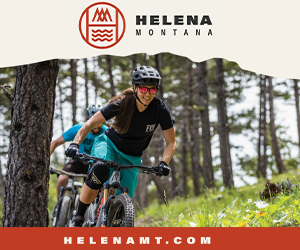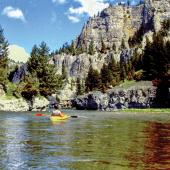A League of Their Own
For these three stalwarts of southwest Montana's recreation scene, building an outdoor community is a labor of love.
Bozeman didn’t become an outdoor town by accident. Over the last several decades, many, many people have dedicated countless hours to races, trails, parties, and festivals to create the vibrant recreational community so many of us value today. They’re often unsung heroes, operating behind the scenes and without fanfare—just getting shit done. We thought it was high time to shed some light on a few of these selfless souls who are out there making southwest Montana a cooler place.
Trailblazer: Tim Hawke
There aren’t many people more affable than Tim Hawke. He’s friendly, unfiltered, direct, and rough around the edges in a way that’s endearing rather than off-putting. He’s a native Montanan, and wears the distinction with pride—talk with him for five minutes and his love for the state becomes evident. These attributes, along with tireless persistence, have helped establish Hawke as a leading local advocate for trails in southwest Montana. He’s the architect of the fledgling Copper City Trails outside Three Forks, where last year volunteer crews broke ground on what will become 18-25 miles of low-elevation, multi-use singletrack, spread across 2,500 acres of public BLM land.
Hawke, 45, first proposed Copper City Trails a decade ago, and has been working on them ever since—up to 40 unpaid hours a week, as a passionate volunteer and Southwest Montana Mountain Bike Association (SWMMBA) project manager—to see his vision through. But what he sees is more than just a system of trails for bikers and hikers—it’s a community of people invested in recreation, stewardship, and each other. “I want it to be more than the mountain-bike community out there,” he says. “I want it to be the community community.”
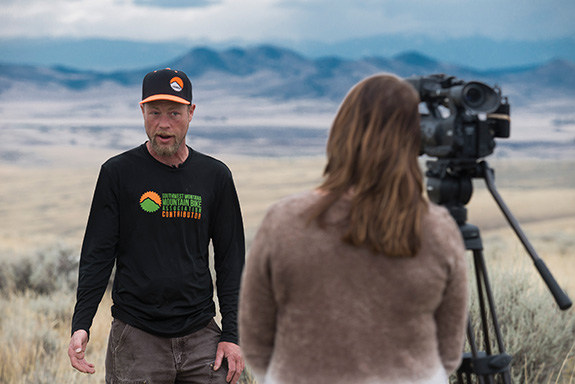
After all, a desire to ride bikes doesn’t explain Hawke’s self-professed obsession with trail work. The effort simply isn’t worth it, if riding was the only motivation. The trails—and perhaps more critically, the process of bringing people together to get the trails built—represent for Hawke a purpose and chance for a legacy. “I decided a long time ago I didn’t want to have kids,” he says, “but I do want to leave the world a better place. Building trails is what I can do. Joining the tribes. Taking responsibility.”
And it’s the interrelated ideas of local community and personal responsibility that has Hawke fixated. “I want to show what having a trail system can do for a small Montana town,” he says. Fruita, Colorado—a small farming town similar to Three Forks that has become a mountain-biking Mecca—is a shining example of the impact a popular trail system can have. “Mountain bikers spend $7 million a year in Fruita,” Hawke says. “Think of what that could do for this place.”
Hawke lived in Bozeman for 25 years, before moving to Three Forks last year. It put him closer to Copper City, where he visits every day to check on trail conditions and usage; but the move wasn’t one of convenience. Between Bozeman’s exploding cost of living, and the amount of unpaid time Tim was putting into the Copper City project, he was priced out. “[This project] broke me financially,” he explains. “I had to move away. But Three Forks is a great little town.” His new neighbors brought him a plate of bacon his first morning—a Montana take on the traditional welcome basket.
In addition to advocating community involvement, Hawke also proposes a fundamental shift in the way recreationists interact with our public lands—lands until now developed and maintained largely by government agencies.
“It’s up to the users to take responsibility for these places,” he explains. “The USFS, the BLM, the NPS—they don’t have the money or people anymore. They’ve been gutted. It’s up to us.” His experiences navigating the bureaucratic, social, and financial labyrinth of getting Copper City off the ground support his assessment. “The BLM is full of great people,” he says. “They’re doing their jobs, but they don’t have any [resources]. It’s on us—and this stuff doesn’t just happen. It takes community.”
He’s a firm believer that every user must contribute, even in the smallest ways. “Every time you go out, do a little something,” he suggests. “Cut a branch off the trail, drain a puddle. Every day should be a trail day—even if it’s just five minutes.”
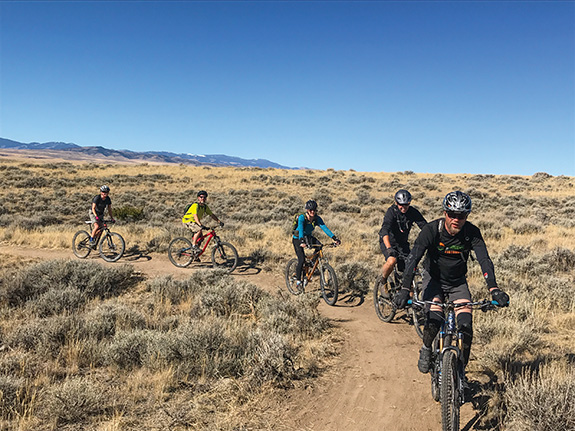
A wood finisher by trade, Hawke knows hard work. His battered workman’s hands tell the story, and he relishes his role, despite the many challenges he’s faced along the way. “Personal networking is still how you get things done,” he says. “Real Montana—you meet in person and shake hands.” One of his proudest moments was on National Trails Day last year, when 175 people showed up to swing tools, collect trash, and care for our shared public space at Copper City. “I was blown away,” he says.
Copper City is slated to take three years to complete—a timeline Hawke thinks will run long—but he’s already planning the next project. He’s hoping that someday he can parlay his years of volunteer experience and connections into a paid position, but in the meantime, he remains passionately engaged and unflinchingly optimistic about developing a world-class trail system in southwest Montana. He rattles off potential trail sites—most in places well off the beaten path—with excitement flashing in his eyes. “I’m an obsessed explorer,” he says. “I grew up in Montana and I want to know all of her—I’m kind of a nutjob that way.”
But in the end, for Hawke the conversation always seems to return to people helping people, and communities coming together for a common cause. Trails are uniting—they are places to play and learn and meet and grow. For some, like Hawke, trails have become a way to make something positive and lasting—something greater than himself. “Last fall, we cut the ribbon at Copper City on National Public Lands Day,” he recounts, “and 100 people took off down the trail. Whole families were there, riding together. That’s what makes me really happy.” —DREW POGGE
Ridge Runner: Darryl Baker
There are many people, places, and organizations that make Bozeman, well, Bozeman. Names like Bridger, Lewis & Clark, Story, and Willson; places like Lindley Park, the MSU Duck Pond, the Hot Springs, and the ‘M’ Trail; and organizations like Sweet Pea, Shakespeare in the Parks, the Emerson Center, and the Big Sky Wind Drinkers.
Wait a minute, what was that last group, the Wind Drinkers? Founded in 1973, BSWD is Bozeman’s nonprofit running club boasting over 200 members. The club hosts free weekly fun runs throughout the summer that attract Bozemanites of all ages and interests, and they organize many iconic running events, most notably the Bridger Ridge Run, the Sweet Pea Run, the Old Gabe Trail Run, and the John Colter Run. Like many local nonprofits, BSWD runs on hours and hours of volunteer efforts, and when it comes to time served, Darryl Baker leads the way.
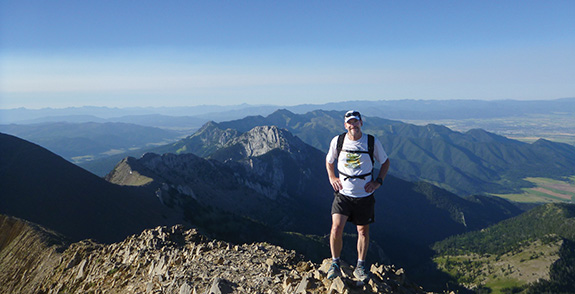
Baker, a youthful 62 years old, spent some of his early years in Bozeman while his father attended MSU, later attending MSU himself and earning a civil engineering degree. Eventually, his career brought him back to Bozeman in the 1990s. In 2000, Baker’s daughter participated in the Sweet Pea Run, and he was surprised to see so many adults running in the race. His curiosity piqued, Baker decided to get involved and learn about the BSWD running club and its activities. He hasn’t looked back since.
Officially, Baker is the club’s membership chair, keeping track of rolls and renewals. Unofficially, he’s the club’s “difference equation.” When there’s a gap between what is being done and what needs to be done, Baker steps in to make up the difference.
Baker’s dedication to the John Colter Run is legendary. He was a big fan of the run for many years, and when the original sponsor discontinued the event several years ago, Baker was instrumental in getting it re-established under the Big Sky Wind Drinkers. He has become the race’s great ambassador, always encouraging participation by young and old, carefully marking the course with cairns, teepees, and other decorations. Kurt Buchl, the race director, gets a huge boost from Baker’s knowledge and infectious enthusiasm for the race. The runners know Baker’s face because of his big smile and quiet words as he hands out the awards. Most runners also know Baker’s heart, because of his joy—and maybe a tear—when posing with the youngest and oldest participants for a post-race photo. In recent years, that’s been a six-year-old and a 90-year-old.
A dedicated runner himself, Baker has participated in numerous club events, including 14 completions of the gnarly Bridger Ridge Run. For the last several years, Baker’s been a key organizer of the water-haul that starts a couple months before the August race day. The aid-station locations are all up on the spine of the Bridgers, in locations accessible only by foot. So, volunteers haul on their backs nearly 1,700 pounds of water in 2.5-gallon jugs, each weighing 20 pounds, up to the aid stations high atop Bridger Bowl, Baldy Mountain, and the Halfway-to-Baldy station. While it sounds like this effort might require someone cracking a whip at the volunteer’s feet, Baker is able to encourage the volunteers with a smile and a sincere belief in “living every day the best we can.”
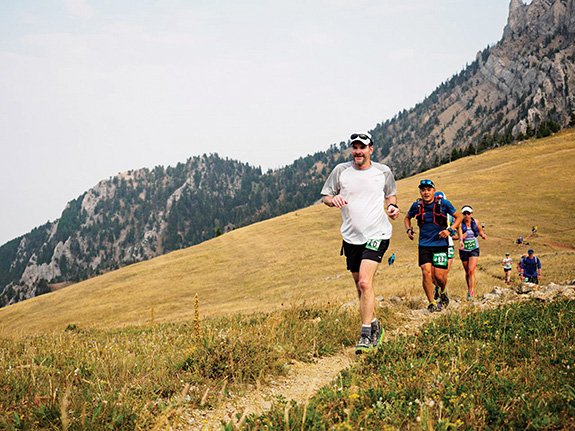
Now retired, Baker’s schedule is a bit more flexible. He loves spending time with his granddaughters, plus getting out skiing, hiking, and running as much as ever. He says with a sigh, “What a beautiful place we live in; there may not be a better environment to live in if you love the outdoors as much as I do.” —ROB MAHER
Gallatin Guru: Dave Schroeder
It’s spring and you’re driving south on Hwy. 191. Eventually, the Gallatin River comes into view and the brown water becomes more turbulent the further you drive. Soon, a bearded man in a tiny red boat appears on the water—plastic paddles strapped to each hand. He gracefully slides over waves, initiating cartwheels and flips as he paddles downstream. A trucker and a tourist are stopped along the pullout, ogling the picturesque scene, which has undoubtedly been witnessed by thousands of southwest Montana residents. But who is this staple Gallatin kayaker?
His name is David Schroeder, and he arrived in Bozeman in the summer of 1997. He was roaming the West, looking for a place to settle after a commercial fishing stint in Alaska, and by ’98, he found himself working for Pat Dillon’s Adventures Big Sky. It was here that he picked up kayaking on the Gallatin River.
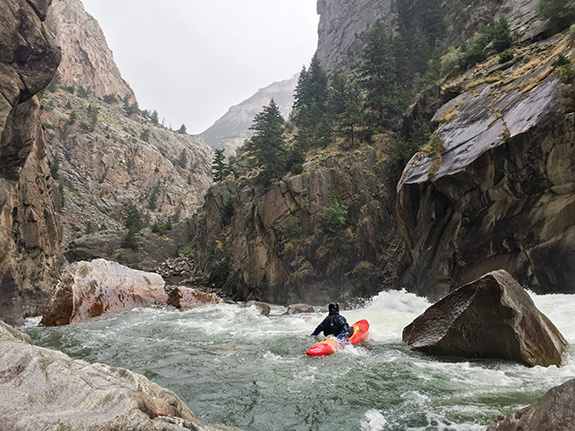
“This place has always attracted folks wandering about. Sometimes it holds on for just a season, and sometimes it becomes home,” says Schroeder. Twenty years later, he’s a father, husband, business owner, and the unofficial mayor of kayaking the Gallatin.
After paddling for two decades in the area, he’s been able to watch and be a part of the many iterations of the Bozeman kayaking scene, including the heyday centered around the Nurpu crew and their beautifully documented Teton Gravity Research exploits. (See TGR’s Nurpu and Wehyakin movies from the early 2000s.) He also had the first descent on Big Sky’s Ousel Falls on the West fork of the Gallatin in ’03, slipping in a clean line just a couple of days before local Nurpu legends Matt Wilson and Alex Allen gave it a go, with Allen's run ending in an unfortunate spinal injury when he struck bottom of the shallow landing zone. A few days later, at the TGR film premiere, the Nurpu / Montana Surf crew made good on their guidebook's word with an impromtu whiskey session in the bowels of the Emerson Theatre. “My 15 minutes of fame was up, with only an hour and a half or so of infamy yet to be played out,” he says. “Ousel Falls has not been run much since, that I’m aware of.”
Since then, Schroeder has focused on raising a family and building a business, while not allowing his presence in the kayaking community to dwindle. He’s helped organize four Gallatin Whitewater Festivals, three Quake ’n’ Bakes on the upper Madison, and three separate kayak events on Big Timber Creek.
“Over the years, [area paddler] Jonas Grenz had tossed out the idea of a relay race on Big Timber Creek. From that seed, Jason Matthews and I hatched the plan for the first Big Timber Creek Race. On June 9, 2007, just over 30 creek boaters raced from above the Pinch to the first bridge. At the time, it was easily one of the steepest kayak races in the world,” Schroeder explains.
Soon after, tragedy struck at a Quake ’n’ Bake event on the Madison. “Rob Kindle, a local legend and just an all-in-all good man, died while getting his warm-up lap in on the swollen course,” says Schroeder. Coupled with criticism from much of the community, his race organization efforts faded. “It was so sad and tragic,” he remembers. “My desire to race and be involved in whitewater events left me for several years.”
Later, Schroeder started paddling and racing again with his close friend and local paddler Nate Winning, who revitalized Schroeder’s interest in both the Big Timber and Quake’n’ Bake races. In 2016 and 2017, Schroeder and Winning, along with fellow kayakers Eric Grey and Eric Ducomb, officially resurrected the Big Timber Creek event. The group blocked out the Half Moon campground, providing race insurance through Winning’s Beartooth Paddlers Society, and providing low race fees and free food to competitors.
The Forest Service, however, soon caught on to the cowboy-like organization of the two most recent events, and decided they would have a say in the future. “After a scofflaw-esque event last year that didn’t make it under the Forest Service’s radar, we will now be working hand-in-hand with the aforementioned on this year’s event,” says Schroeder. “I’m confident that we can keep the roots of the Big T race intact, while keeping within the wishes and good graces of the Forest Service.”
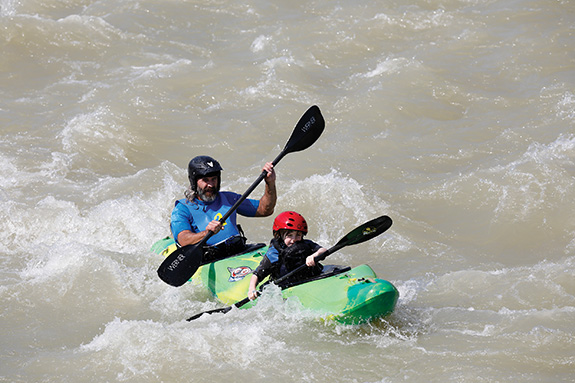
As for motivation, Schroeder doesn’t really see himself as a community builder. “I just aim to create opportunities for whitewater folks to have a really good time and, hopefully, deliver a memorable experience. I do hope that as the community grows, that it never loses touch with its rowdy roots. Wild rivers and wild people belong together.” —KEVIN KENNEDY








